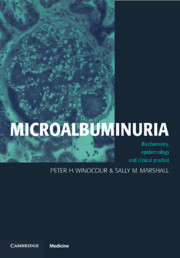Book contents
- Frontmatter
- Contents
- Preface
- Foreword by Professor K. G. M. M. Alberti
- 1 Renal structure and physiology
- 2 Measurement and expression of microalbuminuria
- 3 Epidemiology and determinants of microalbuminuria in health
- 4 Microalbuminuria in diabetes mellitus
- 5 Microalbuminuria as a marker of endothelial dysfunction
- 6 Microalbuminuria, cardiovascular risk factors and cardiovascular disease
- 7 Microalbuminuria as a non-specific marker of disease
- 8 The management of microalbuminuria in diabetes mellitus and essential hypertension
- Index
Foreword by Professor K. G. M. M. Alberti
Published online by Cambridge University Press: 06 July 2010
- Frontmatter
- Contents
- Preface
- Foreword by Professor K. G. M. M. Alberti
- 1 Renal structure and physiology
- 2 Measurement and expression of microalbuminuria
- 3 Epidemiology and determinants of microalbuminuria in health
- 4 Microalbuminuria in diabetes mellitus
- 5 Microalbuminuria as a marker of endothelial dysfunction
- 6 Microalbuminuria, cardiovascular risk factors and cardiovascular disease
- 7 Microalbuminuria as a non-specific marker of disease
- 8 The management of microalbuminuria in diabetes mellitus and essential hypertension
- Index
Summary
The appearance of small amounts of albumin in the urine, which were less than those detected by conventional methods at the time but higher than normal, was first noted by Professor Keen and colleagues in the 1960s. Little further was done for 15 years until groups in London and Denmark started to look in more detail at urine protein excretion in people with diabetes. This intermediate grade of proteinuria between dip-stick detectable and normal was referred to as microalbuminuria – a totally inaccurate name but one that has stuck! Since then a vast amount of work has accumulated and many publications on the subject have appeared. Of particular interest is the fact that these small amounts of protein in the urine are associated not just with more rapid progression to end stage renal failure but with subsequent cardiovascular disease mortality and morbidity. Initially, studies focused on type 1 diabetes, but now there is much literature on type 2 as well, and increasing awareness of the relevance of microalbuminuria in non-diabetic renal and vascular disease.
For many physicians the amount of literature on microalbuminuria is overwhelming and hence tends not to be read. The present book by Drs Winocour and Marshall provides a succinct account of what we know about microalbuminuria, not just in relation to renal function but with regard to the broader aspects of diabetes. The book fills a large gap in the diabetes and renal literature.
- Type
- Chapter
- Information
- MicroalbuminuriaBiochemistry, Epidemiology and Clinical Practice, pp. ix - xPublisher: Cambridge University PressPrint publication year: 1998



